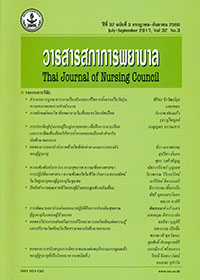ปัจจัยทำนายคุณภาพชีวิตผู้ป่วยกระดูกสันหลังเสื่อม
Keywords:
spinal degenerative disorders, quality of life, pain, disability, depressionAbstract
Abstract: Objective: To determine the predicting factors among number of degenerative level, pain, disability, depression, and quality of life of person with spinal degenerative disorders.
Design: Correlational predictive research.
Methods: The sample consisted of 84 individuals who had spinal degenerative disorders receiving conservative treatment at Orthopedics Department, University hospital, in Bangkok. Number of level spine pathology, pain level assessing by Visual analog scale, and disability level using Neck disability index and Oswestry disability index were collected. The Center for Epidemiological Studies Depression Scale was utilized to assess depression. The EQ-5D-5L was used to determine quality of life. Weighted Lease Square Regression analysis with Enter method was conducted to analyze the power of predictors in this study.
Main findings: The majority of sample is female (73.6%) and have more than 1 level or multilevel of spine pathology (63.1%). The average age was 63.82 years (SD = 10.13). Moderate pain (= 48.25, SD = 24.26) and mild disability levels (= 31.93, SD = 15.46) were reported with no depression (= 13.44, SD = 8.51). The average quality of life score was 66.24 (SD = 17.77). Variances of quality of life predictors were accounted for 26.5% (R2 = .265, F = 7.118, p<.05). Particularly, pain and depression are significant predictors of quality of life (β = -.273, -.262, p<.05, respectively)
Conclusion and Recommendation: Nurse should assess and manage depression and pain in persons with degenerative disc disorders receiving conservative treatment because they have significant impact on quality of life.
Keywords: disorders, quality of life, pain, disability, depression
Downloads
References
countries? a systematic critical literature review.Chiropr Man Therap. 2012;20(1):31-82.
2. Otani K, Kikuchi S, Yabuki S, Igarashi T, Nikaido T, Watanabe K, et al. Lumbar spinal stenosis has a
negative impact on quality of life compared with other comorbidities: an epidemiological cross-sectional
study of 1862 community-dwelling individuals. Sci World J. 2013:590652. doi: 10.1155/2013/590652.
3. Stamm TA, Pieber K, Crevenna R, Ernst Dorner T, Dorner TE. Impairment in the activities of daily
living in older adults with and without osteoporosis, osteoarthritis and chronic back pain: a secondary
analysis of population-based health survey data.BMC Musculoskelet Disord. 2016;17:1-10.
4. Darzi MT, Pourhadi S, Hosseinzadeh S, Ahmadi MH, Dadian M. Comparison of quality of life in
low back pain patients and healthy subjects by using WHOQOL-BREF. J Back Musculoskelet Rehabil.
2014;27(4):507-12.
5. Whittle IR, Scotland J, Dengu F, Anpalakhan S, Deary IJ. Preoperative quality of life in patients with
degenerative spinal disorders: many are worse than patients with brain tumours and cancer. Br J Neurosurg.
2012;26(4):460.
6. Misiak B, Snarska K. Quality of life of patients with back pain. J Neuro Neurosurg Nurs. 2014;3(3):
107-15.
7. Sigmundsson FG. Impact of pain on function and health related quality of life in lumbar spinal stenosis:
a register study of 14,821 patients. Spine. 2013; 38(15):E937.
8. Hong JH, Lee MY, Jung SW, Lee SY. Does spinal stenosis correlate with MRI fndings and pain,
psychologic factor and quality of life? Korean J Anesthesio. 2015;68(5):481-7.
9. Kaptan H, Yalçın ES, Kasımcan Ö. Correlation of low back pain caused by lumbar spinal stenosis and
depression in women: a clinical study. Arch Orthop Trauma Surg. 2012;132(7):963-7.
10. Özdemir E, Paker N, Bugdayci D, Tekdos DD. Quality of life and related factors in degenerative
lumbar spinal stenosis: A controlled study. J Back Musculoskelet Rehabil. 2015;28(4):749-53.
11. Roopsawang I, Aree-Ue S, Putwatana P. A follow-up study of health status in patients with chronic low back
pain before and after spinal surgery. Rama Nurs J. 2009;15(3):344-60. [in Thai]
12. Meleis AI, Sawyer LM, Im E-O, Hilfnger Messias DK, Schumacher K. experiencing transitions: an
emerging middle-range theory. Nurs Sci. 2000; 23(1):12-28.
13. Cohen J. A power prime. Phychol Bulletin. 1992; 112(1) ;129-59
14. Melzack R. The short form McGill pain questionnaire. Pain. 1987; 30 (2);191-7.
15. Uthaikhup S, Paungmali A, Pirunsan U. Validation of Thai versions of the neck disability index and neck
pain and disability scale in patients with neck pain. Spine. 2011;36(21):E1415-21.
16. Sanjaroensuttikul N. The Oswestry low back pain disability questionnaire (version 1.0) Thai version.
J Med Assoc Thai. 2007;90(7):1417-22.
17. Kuptniratsaikul V, Pekuman P. The study of the Center for Epidemiologic Studies-Depression Scale (CES-D)
in Thai people. Siriraj Med J. 1997;49(5):442-8.
18. Butsankot P, Thosingha O, Chanruangvanich W , Chawasiri C. The influence of comorbidity, body mass
index, and depression on post-operative recovery among patients undergoing lumbar surgery. J Nurs
Sci. 2016;34(2 supp.1):129-41. (In Thai)
19. EuroQol. A new facility for the measurement of healthrelated quality of life. Health Policy. 1990;16(3):
199-208.
20. Drury T, Ames SE, Costi K, Beynnon B, Hall J. Degenerative spondylolisthesis in patients with neurogenic
claudication effects functional performance and selfreported quality of life. Spine. 2009;34(25):2812-7.
21. Kim KH, Moon S-H, Hwang C-J, Cho YE. Prevalence of neuropathic pain in patients scheduled for lumbar
spine surgery: nationwide, multicenter, prospective study. Pain Physician. 2015;18(5):E889-E97.
22. Lubelski D, Bansal S, Mroz TE, Mazanec DJ, Benzel EC, Khalaf T, et al. Depression as a predictor of worse
quality of life outcomes following nonoperative treatment for lumbar stenosis. J Neurosurg Spine.
2015;22(3):267-72.
23. Saejong P, Ho Sung H, Gang-Un K, Sung Shik K, Ho-Joong K, Mihyun L, et al. Relationships among
disability, quality of life, and physical ftness in lumbar spinal stenosis: an investigation of elderly korean
women. Asian Spine J. 2017;11(2):256-63.
24. Park DK, An HS, Lurie JD, Zhao W, Tosteson A,Tosteson TD, et al. Does multilevel lumbar stenosis
lead to poorer outcomes?: a subanalysis of the spine patient outcomes research trial (SPORT) lumbar
stenosis study. Spine. 2010;35(4):439-46.








